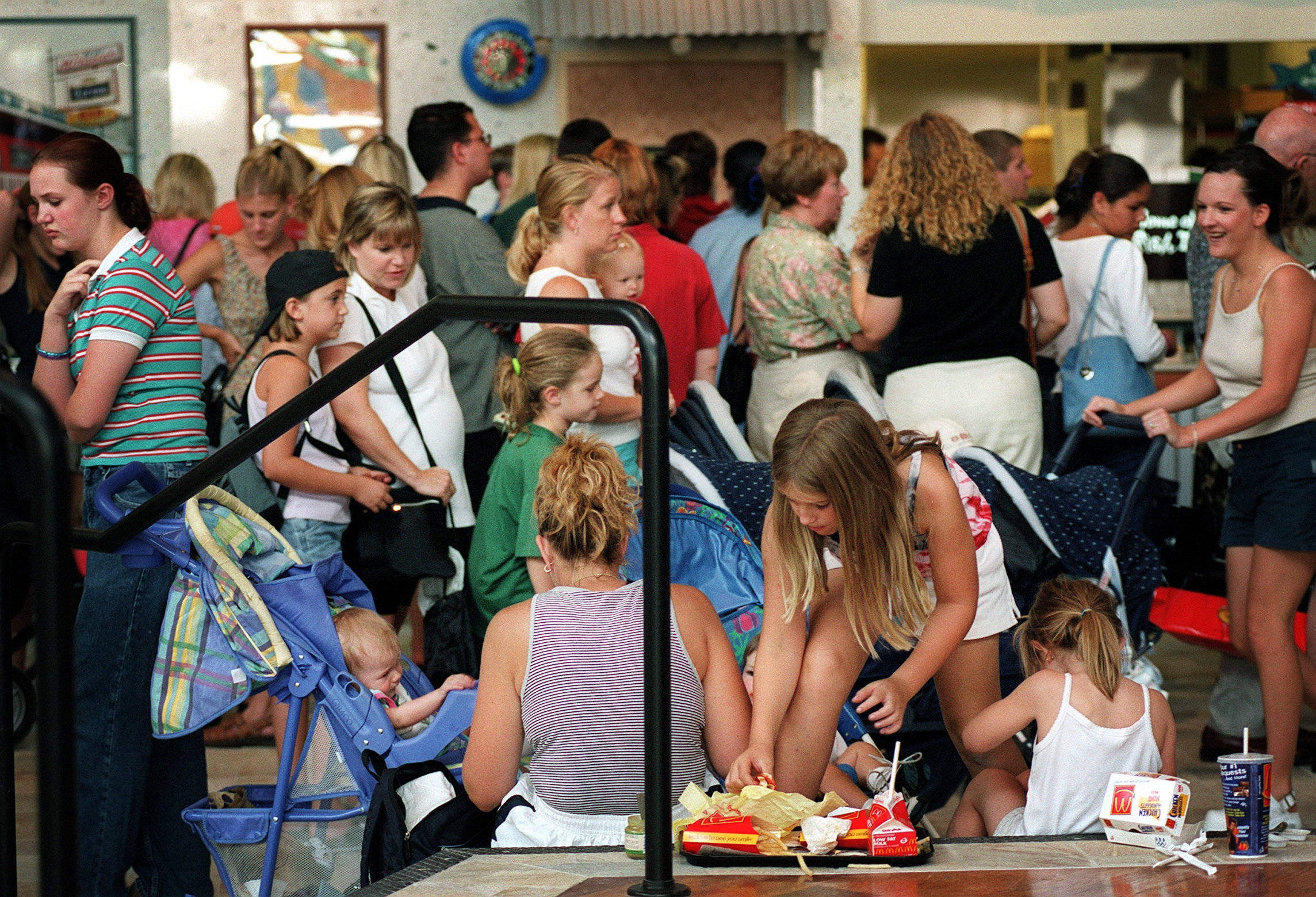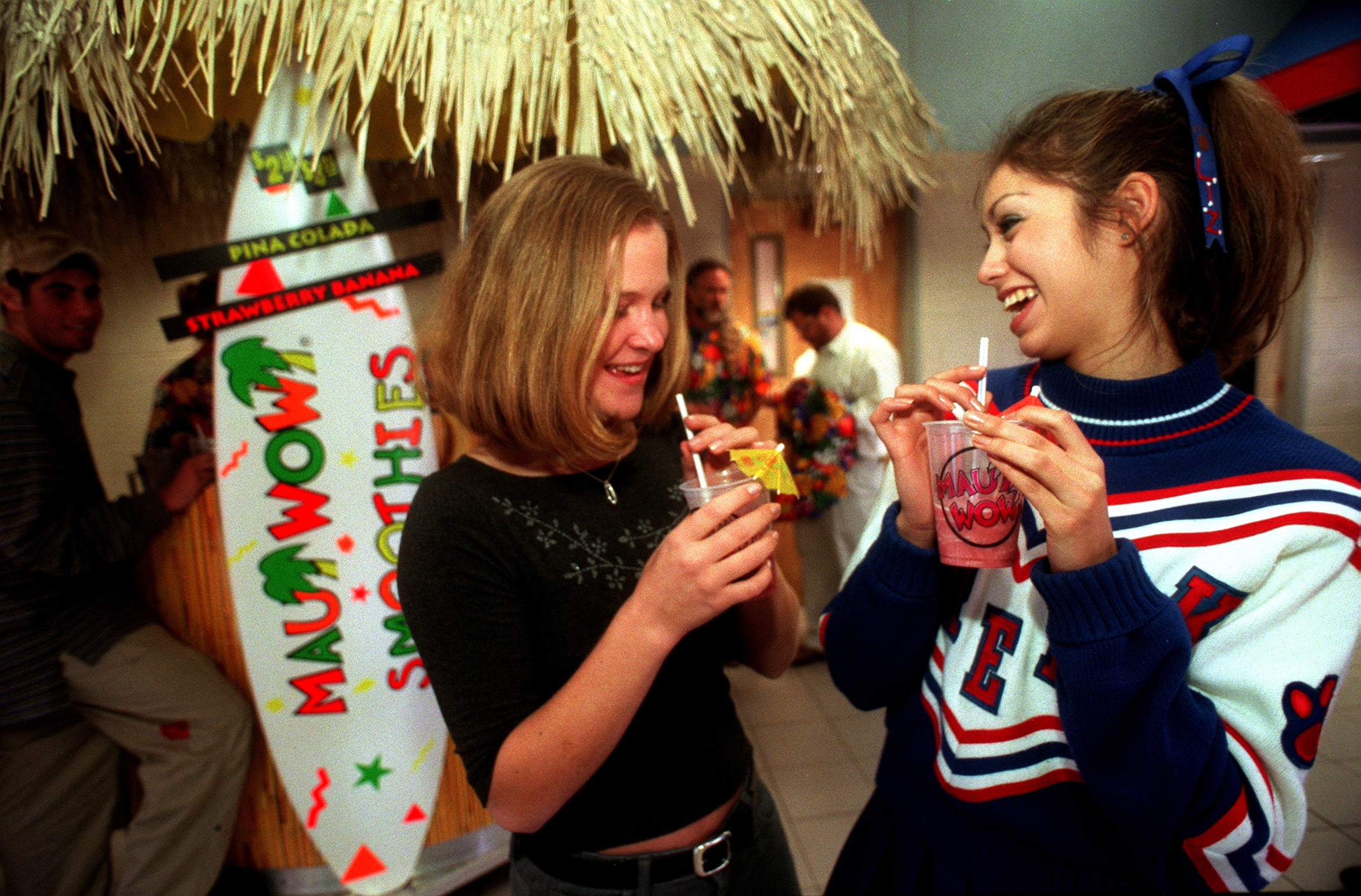In Memoriam: The Trashy Mall Food Court Smoothie of the 90s
Credit to Author: Kelsey Lawrence| Date: Tue, 14 May 2019 16:11:41 +0000
“Mall smoothie” is a surprisingly prolific search on Twitter.
When I worried that the mall food court smoothie was somehow maybe both too niche and too broad of a topic to reflect upon, the highly specific nostalgic yearnings of internet culture pulled through. Within only a four-day period from when I first thought of writing about the mall smoothie, people had tweeted: “whyyyyy am i craving one of those smoothies from the food court at barton creek mall”, “I stay going to the mall JUST for a smoothie”, and “A smoothie from the mall would be so amazing right now”. With the exception of perhaps the vaunted Auntie Anne’s pretzel, I’m not sure there’s another snack as closely associated with teen mall-rat culture as the smoothie.
While mall smoothies didn’t turn out to be the healthy snacks we may have once thought they were, there’s something I miss about a time when the idea of health and wellness didn’t come with an $8-per-drink price tag and a tightly curated, aggressively marketed lifestyle behind it. With brands now a mishmash of Helvetica, austere design, all forms of kale, and boutique fitness, the basic food-court smoothie seems innocently retro. Maybe I’m also experiencing some sleek, pastel-branded fatigue where a product isn’t supposed to just be the best—it’s supposed to make us better people.
Mall smoothies came with an amorphous suggestion of nutritional soundness, but were far from elitist. Coming from businesses both franchised and locally owned, often with vague-geographic-destination names like Planet Smoothie, they were the sippable staples that once felt so chic to order as a teen. Of course, now the “smoothie place” as we know it has updated to keep with today’s fast-casual trends—more things in bowl form, and more leafy greens—but ultimately, the drinks largely remain simple: fruit thrown in a blender with some milk or yogurt, or maybe a scoop of protein powder for the more serious consumers. “Jamaican Jammer” was the strawberry-banana-yogurt concoction I ordered as a middle-schooler—or sampled in that small, white paper cup—and others like “Mango Me Crazy” or “Peach on the Beach” were equally uncomplicated blends.
The official genesis of the smoothie as it became popular in the United States (yogurt-based drinks like lassi have been consumed by other cultures for hundreds of years) is hard to trace. We know that a Polish-American chemist named Stephen J. Poplawski invented the blender in 1922. TV personality, big band leader, and blended-drink fan Fred Waring redesigned and popularized his own blender—the Waring Blender—in 1937.
In search of early smoothie recipes, food historian Sarah Wassberg Johnson thumbs through early celebrity nutritionist Adelle Davis’ classic cookbook Let’s Cook It Right. Published in 1947, a lot of the book’s health advice was based off suggestions given during World War II. Johnson finds a recipe in the book for a sort-of raspberry yogurt smoothie that calls for canned raspberries, powdered milk, and yogurt.
“Americans don’t really associate [yogurt-based drinks] with health food until the 1960s and 70s, in large part thanks to Adelle Davis,” Johnson says. “In the 60s and early 70s, she really introduces a lot of ordinary Americans to yogurt and granola and those sorts of health foods that were really popularized at that time.”
The modern mall was also born during this era. To entice shoppers to spend more time at the mall, urban developer and mall pioneer James Rouse designed a prototypical food court for Pennsylvania’s Plymouth Meeting Mall in 1971, but it didn’t take off due to its lack of selection and small size. In 1974, he created the first successful food court in New Jersey at Paramus Park. By the early 80s, the mall was a well-established teen hangout spot, with movies like 1982’s Fast Times at Ridgemont High and 1983’s Valley Girl using the suburban shopping center—particularly the food court—as the social nexus where things happened.
The smoothie—a portable, one-handed drink that allows you a healthy(ish) snack while carrying around your shopping bags—was the perfect retail accessory. Orange Julius, a creamsicle-esque precursor to the mall smoothie, became a food court staple as early as the 1960s, when the company’s locations moved from the streets to the first shopping malls. Johnson speculates that the drink became popular because no one knew the recipe and “it seemed a bit more special.” When images from the set of a fictional 80s mall built for Stranger Things’ Season 3 began to circulate, an Orange Julius could be seen in the food court.

It was during the 1980s fitness craze, when health clubs and exercise-as-lifestyle trends took off, that smoothies evolved from a niche beverage into a more mainstream (faux) health-food product. In the early 90s, the smoothie chains we see now in malls began to pop up, with Jamba Juice founded in 1990, Planet Smoothie in 1995, and Tropical Smoothie Cafe in 1997.
“If you think about any retailer, the most broad exposure they’re going to get with foot traffic is likely in a good mall, underscoring the word ‘good,’” says Naveen Jaggi, president of retail advisory services for commercial real estate services firm Jones Lang LaSalle. “Food courts being an important element of the mall coming out of the 70s, it was easy for a Smoothie King or anything in that category to do a lease at a food court—high visibility, high brand awareness, successful co-tenancy with other food purveyors around them.”
“If I’m honest with myself, I only really like those trashy smoothies that are basically candy. As a teen, I definitely was the one who would go to Jamba and get the peanut butter chocolate smoothie, which was basically a shake.”
“You know how a lot of mall smoothie places also have frozen hot chocolate?” Johnson says, “I have a 1920s electric refrigerator cookbook that talks about frozen hot chocolate. I think the thing about smoothies is that they became considered [probably] more healthful than milkshakes, even though nutritionally, they’re basically milkshakes [because of] their sugar content.”
Smoothie King just opened its 1,000th store last August—a standalone, brick-and-mortar location in Richardson, Texas. Ranking number 22 on Entrepreneur’s Fortune 500 list, it’s the most successful smoothie franchise, started in 1973 by former soda jerk Steve Kuhnau. He founded Smoothie King in Kenner, Louisiana after being unable to digest the milk in malts and shakes.
In spite of its number-one status, many of the chain’s mall locations are also accompanied by “CLOSED” next to the listing. “For Smoothie King, mall food court locations are currently not as big of a focus area as they once were,” says Smoothie King CMO Rebecca Miller. “However, they are a great way to introduce our brand to new audiences. It is easier to try a new restaurant when you walk by it, see the menu, and get a feel for it without the commitment of having to park your car and walk into a freestanding location.”
When it comes to mega-mall culture, we might not be at the beginning of the end, but at the end of the end, as online retailers have quickly eliminated the need to hit the shopping center for clothes, gifts, or food. Real-estate research firm Cushman & Wakefield reported that mall visits declined by 50 percent from 2010 to 2013, and vacancies remain at a seven-year high of 9.1 percent.
As department stores—and mall anchors—like JCPenney and Macy’s have shuttered thousands of locations in recent years, gyms and fitness clubs have replaced them in many of those empty spaces. A retail consultant told National Real Estate Investor that in 2017, Planet Fitness was the number-one ranked tenant by total new square footage out of all mall and strip center businesses. Flailing malls are courting gyms to replace the anchor stores like Sears and Bon-Ton that have gone bankrupt in the last few years.
In urban areas, places with sleek, lounge-y atmospheres like Joe & the Juice and Pressed Juicery have taken root in retail spaces, offering amped-up, on-trend beverages with ingredients like spirulina, maple water, turmeric, and sea salt. Those drinks are representative of the perfectly optimized lifestyle fuel that we now want our snacks to be—but it kind of makes me miss the Jamaican Jammer.
“Having a smoothie place being a co-tenant to a fitness-oriented development is a wise move,” Jaggi tells MUNCHIES. “Is a mall the only option? The mall is a great option, but today you’re seeing more developers thinking about putting health-oriented shopping centers together where you have a fitness center, you may have a yoga center, and a chiropractic center.”
But for mall purists, that three-ingredient, dessert-esque smoothie is still where it’s at. Emily Faye and Paige Weldon, Los Angeles mall mega-fans and hosts of the podcast Mall Talk, both agree that food court smoothie places selling genuinely healthy beverages is like “McDonald’s selling salads.”

“If I’m honest with myself, I only really like those trashy smoothies that are basically candy,” Weldon says. “As a teen, I definitely was the one who would go to Jamba and get the peanut butter chocolate smoothie, which was basically a shake. For me, Jamba was a classic mall perimeter business, the place we would go once we’d wandered out of the mall proper.”
“Nowadays, I tend more toward a boba tea if I’m having that kind of craving, or if I’m gonna really go for it, just get a chocolate shake at In-N-Out.”
And that may be where the classic mall smoothie has hit a fork in the road, as it lies in the space between justifiably healthy snack and empty-calorie treat. In urban areas, places with sleek, lounge-y atmospheres like Joe & the Juice and Pressed Juicery have taken root in retail spaces, offering amped-up, on-trend beverages with ingredients like spirulina, maple water, turmeric, and sea salt. Those drinks are representative of the perfectly optimized lifestyle fuel that we now want our snacks to be—but it kind of makes me miss the Jamaican Jammer.
“I think we’ve seen that pivot over the last ten years into it being a much more health-conscious meal, as opposed to just being purely a treat,” Jaggi says. “A treat’s never gonna go away, but you’re going to have to diversify to bring foot traffic into your store.”
But here’s hoping, in a time of carefully curated food halls and double-digit juices, that certain nostalgic remnants of the food court—the chain (or local) smoothie place, for instance, with a sugar-sweet utopian name like “Smoothie Paradise” and loud, tropical colors—may always have a place.
The food court smoothie place I remembered from my hometown mall, which was an Atlanta-based chain named Freshens, still exists (thankfully!) and has a menu largely composed of smoothies palatable to both an eight-year-old and your grandmother.
“One of the most burned-in-my-brain images from my childhood mall that has since been redone is the sign from the smoothie place in the food court,” Faye says. “I don’t remember the name, and I only occasionally got smoothies from there, but the sign was all these giant, kitschy 3-D fruits, and it stood out so much in an otherwise totally mundane food court.”
“I loved that sign.”
This article originally appeared on VICE US.